Essay on Managing Risk: Human Fallibility, Just Culture, and Errors
VerifiedAdded on 2022/12/28
|9
|2574
|35
Essay
AI Summary
This essay delves into the critical aspects of risk management, focusing on human fallibility and its implications within organizational contexts. It examines the nature of human errors, differentiating between skill-based mistakes and violations, and explores how these errors can impact workplace safety and overall organizational performance. The essay further analyzes the concept of a "just culture," contrasting it with blame cultures and highlighting its role in fostering openness, accountability, and continuous improvement within organizations. It discusses the importance of learning from mistakes rather than punishing them and how this approach can enhance employee engagement and productivity. The essay also explores the consequences of human errors and their potential impact on various organizational levels, providing insights into how organizations can mitigate risks and promote a safer and more efficient work environment. Ultimately, the essay underscores the significance of understanding human factors and cultivating a supportive organizational culture for effective risk management.
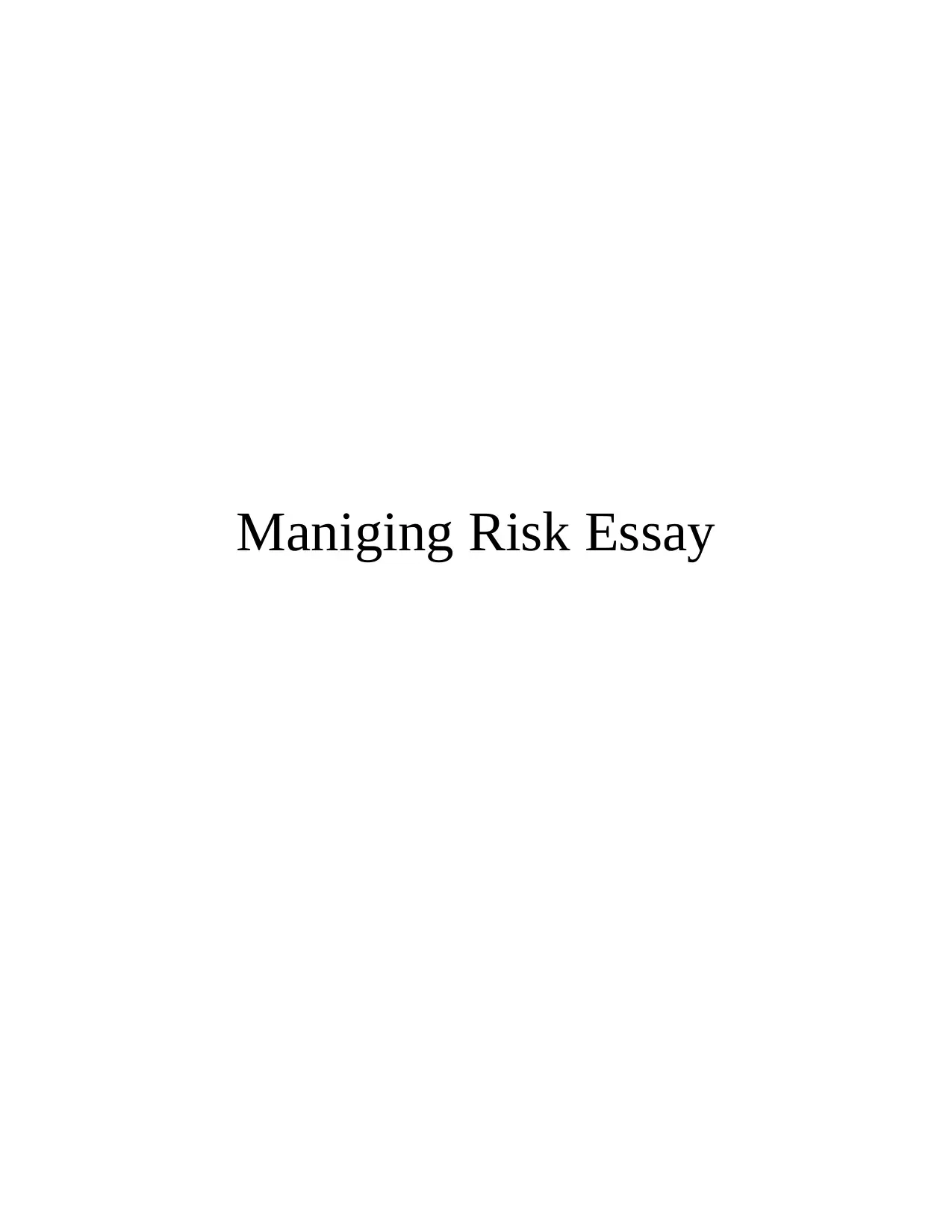
Maniging Risk Essay
Paraphrase This Document
Need a fresh take? Get an instant paraphrase of this document with our AI Paraphraser
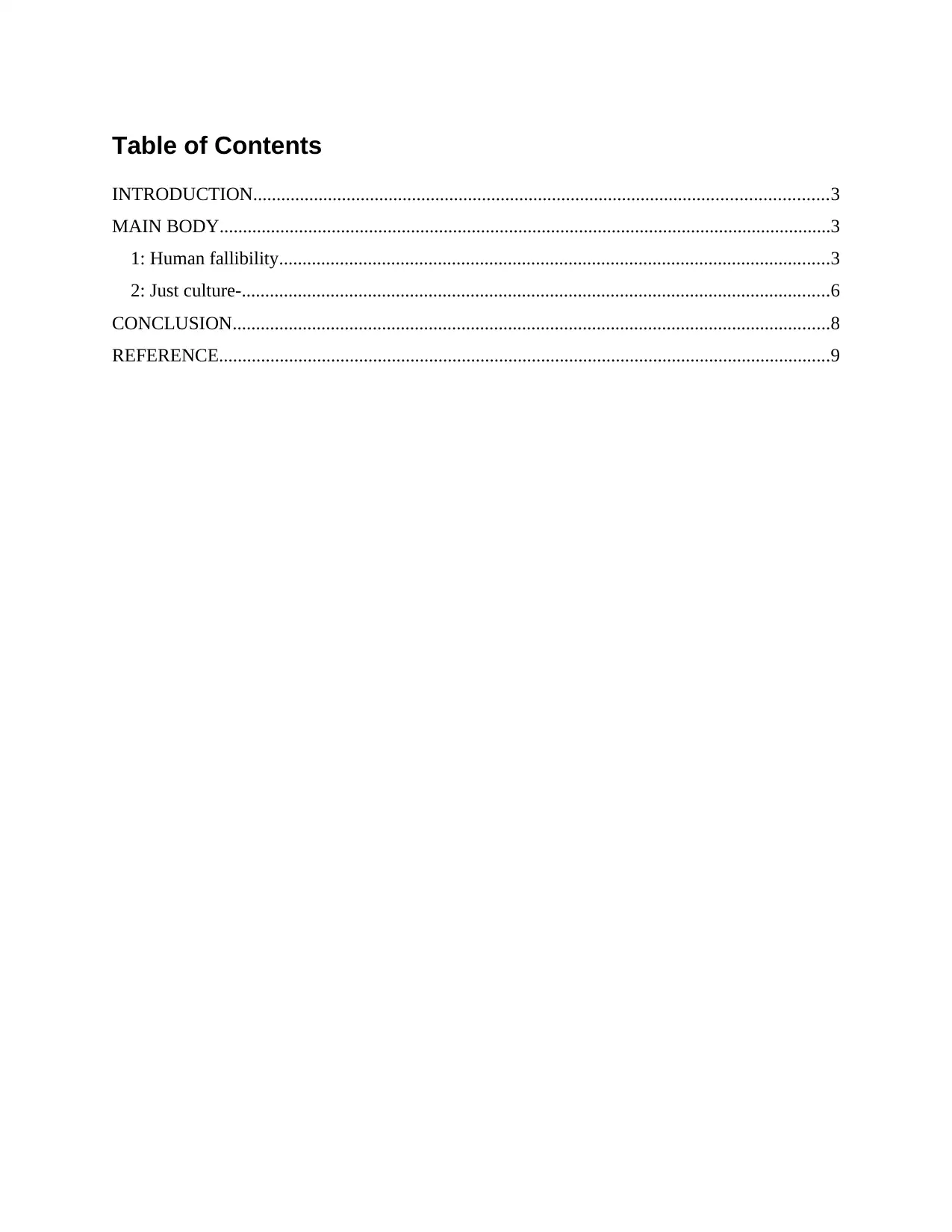
Table of Contents
INTRODUCTION...........................................................................................................................3
MAIN BODY...................................................................................................................................3
1: Human fallibility......................................................................................................................3
2: Just culture-..............................................................................................................................6
CONCLUSION................................................................................................................................8
REFERENCE...................................................................................................................................9
INTRODUCTION...........................................................................................................................3
MAIN BODY...................................................................................................................................3
1: Human fallibility......................................................................................................................3
2: Just culture-..............................................................................................................................6
CONCLUSION................................................................................................................................8
REFERENCE...................................................................................................................................9
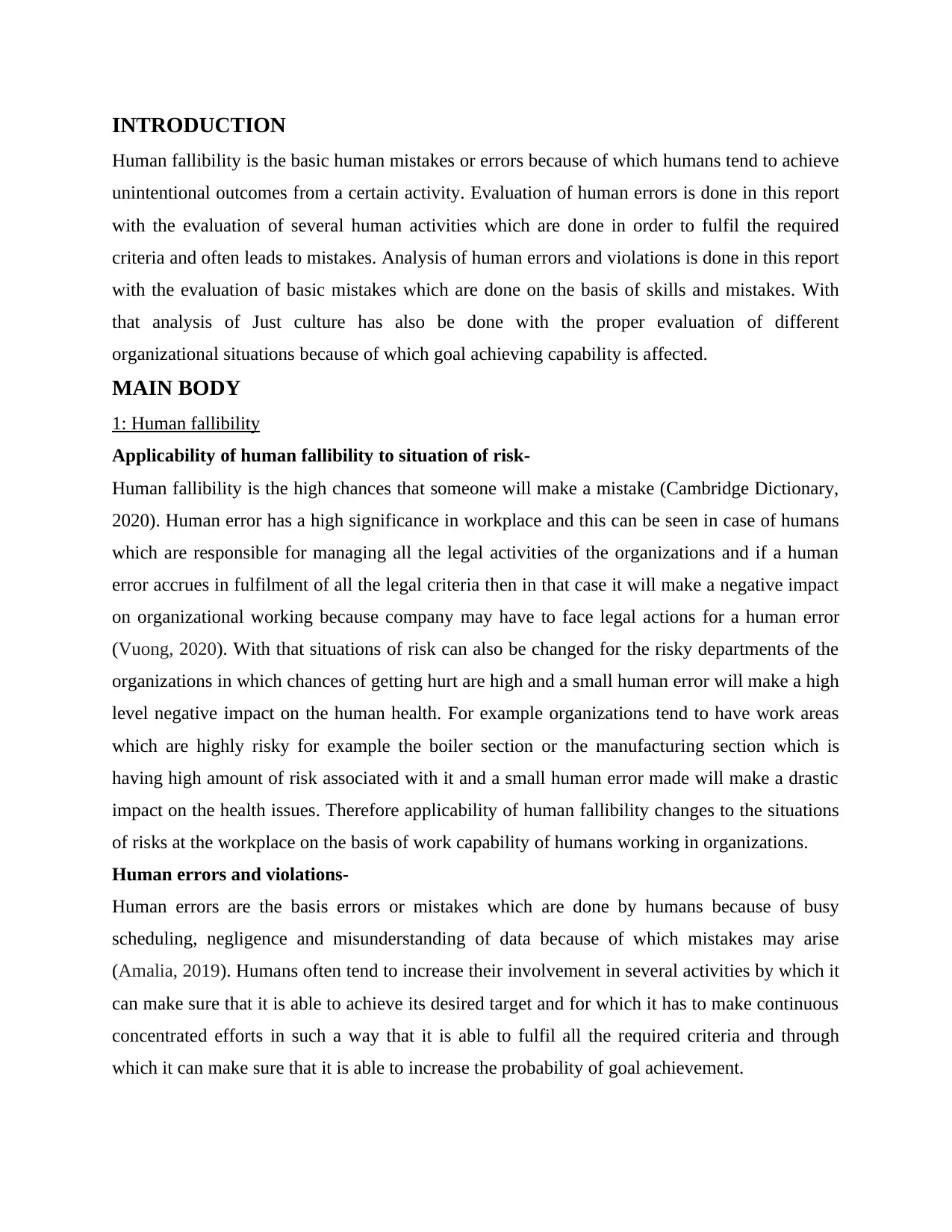
INTRODUCTION
Human fallibility is the basic human mistakes or errors because of which humans tend to achieve
unintentional outcomes from a certain activity. Evaluation of human errors is done in this report
with the evaluation of several human activities which are done in order to fulfil the required
criteria and often leads to mistakes. Analysis of human errors and violations is done in this report
with the evaluation of basic mistakes which are done on the basis of skills and mistakes. With
that analysis of Just culture has also be done with the proper evaluation of different
organizational situations because of which goal achieving capability is affected.
MAIN BODY
1: Human fallibility
Applicability of human fallibility to situation of risk-
Human fallibility is the high chances that someone will make a mistake (Cambridge Dictionary,
2020). Human error has a high significance in workplace and this can be seen in case of humans
which are responsible for managing all the legal activities of the organizations and if a human
error accrues in fulfilment of all the legal criteria then in that case it will make a negative impact
on organizational working because company may have to face legal actions for a human error
(Vuong, 2020). With that situations of risk can also be changed for the risky departments of the
organizations in which chances of getting hurt are high and a small human error will make a high
level negative impact on the human health. For example organizations tend to have work areas
which are highly risky for example the boiler section or the manufacturing section which is
having high amount of risk associated with it and a small human error made will make a drastic
impact on the health issues. Therefore applicability of human fallibility changes to the situations
of risks at the workplace on the basis of work capability of humans working in organizations.
Human errors and violations-
Human errors are the basis errors or mistakes which are done by humans because of busy
scheduling, negligence and misunderstanding of data because of which mistakes may arise
(Amalia, 2019). Humans often tend to increase their involvement in several activities by which it
can make sure that it is able to achieve its desired target and for which it has to make continuous
concentrated efforts in such a way that it is able to fulfil all the required criteria and through
which it can make sure that it is able to increase the probability of goal achievement.
Human fallibility is the basic human mistakes or errors because of which humans tend to achieve
unintentional outcomes from a certain activity. Evaluation of human errors is done in this report
with the evaluation of several human activities which are done in order to fulfil the required
criteria and often leads to mistakes. Analysis of human errors and violations is done in this report
with the evaluation of basic mistakes which are done on the basis of skills and mistakes. With
that analysis of Just culture has also be done with the proper evaluation of different
organizational situations because of which goal achieving capability is affected.
MAIN BODY
1: Human fallibility
Applicability of human fallibility to situation of risk-
Human fallibility is the high chances that someone will make a mistake (Cambridge Dictionary,
2020). Human error has a high significance in workplace and this can be seen in case of humans
which are responsible for managing all the legal activities of the organizations and if a human
error accrues in fulfilment of all the legal criteria then in that case it will make a negative impact
on organizational working because company may have to face legal actions for a human error
(Vuong, 2020). With that situations of risk can also be changed for the risky departments of the
organizations in which chances of getting hurt are high and a small human error will make a high
level negative impact on the human health. For example organizations tend to have work areas
which are highly risky for example the boiler section or the manufacturing section which is
having high amount of risk associated with it and a small human error made will make a drastic
impact on the health issues. Therefore applicability of human fallibility changes to the situations
of risks at the workplace on the basis of work capability of humans working in organizations.
Human errors and violations-
Human errors are the basis errors or mistakes which are done by humans because of busy
scheduling, negligence and misunderstanding of data because of which mistakes may arise
(Amalia, 2019). Humans often tend to increase their involvement in several activities by which it
can make sure that it is able to achieve its desired target and for which it has to make continuous
concentrated efforts in such a way that it is able to fulfil all the required criteria and through
which it can make sure that it is able to increase the probability of goal achievement.
⊘ This is a preview!⊘
Do you want full access?
Subscribe today to unlock all pages.

Trusted by 1+ million students worldwide
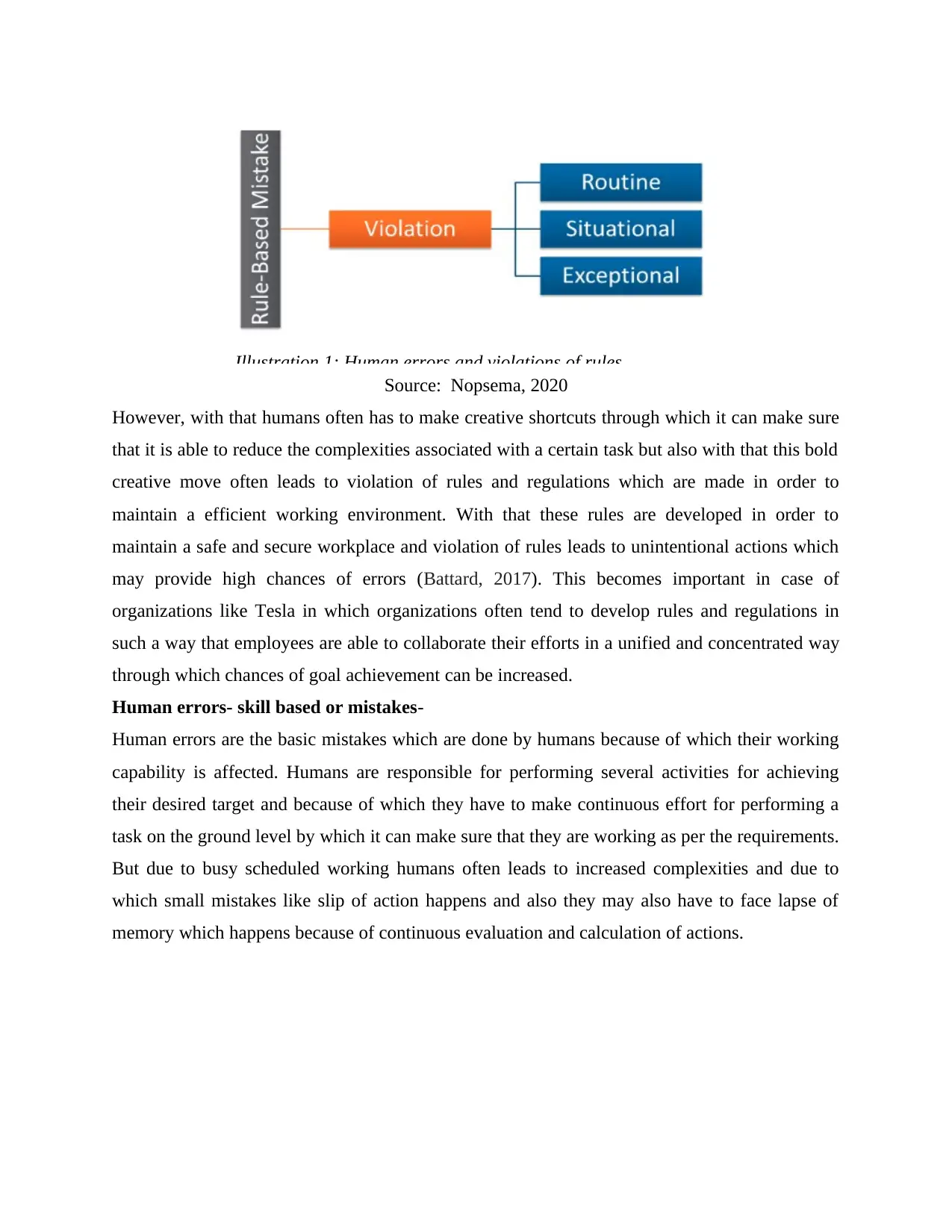
Source: Nopsema, 2020
However, with that humans often has to make creative shortcuts through which it can make sure
that it is able to reduce the complexities associated with a certain task but also with that this bold
creative move often leads to violation of rules and regulations which are made in order to
maintain a efficient working environment. With that these rules are developed in order to
maintain a safe and secure workplace and violation of rules leads to unintentional actions which
may provide high chances of errors (Battard, 2017). This becomes important in case of
organizations like Tesla in which organizations often tend to develop rules and regulations in
such a way that employees are able to collaborate their efforts in a unified and concentrated way
through which chances of goal achievement can be increased.
Human errors- skill based or mistakes-
Human errors are the basic mistakes which are done by humans because of which their working
capability is affected. Humans are responsible for performing several activities for achieving
their desired target and because of which they have to make continuous effort for performing a
task on the ground level by which it can make sure that they are working as per the requirements.
But due to busy scheduled working humans often leads to increased complexities and due to
which small mistakes like slip of action happens and also they may also have to face lapse of
memory which happens because of continuous evaluation and calculation of actions.
Illustration 1: Human errors and violations of rules
However, with that humans often has to make creative shortcuts through which it can make sure
that it is able to reduce the complexities associated with a certain task but also with that this bold
creative move often leads to violation of rules and regulations which are made in order to
maintain a efficient working environment. With that these rules are developed in order to
maintain a safe and secure workplace and violation of rules leads to unintentional actions which
may provide high chances of errors (Battard, 2017). This becomes important in case of
organizations like Tesla in which organizations often tend to develop rules and regulations in
such a way that employees are able to collaborate their efforts in a unified and concentrated way
through which chances of goal achievement can be increased.
Human errors- skill based or mistakes-
Human errors are the basic mistakes which are done by humans because of which their working
capability is affected. Humans are responsible for performing several activities for achieving
their desired target and because of which they have to make continuous effort for performing a
task on the ground level by which it can make sure that they are working as per the requirements.
But due to busy scheduled working humans often leads to increased complexities and due to
which small mistakes like slip of action happens and also they may also have to face lapse of
memory which happens because of continuous evaluation and calculation of actions.
Illustration 1: Human errors and violations of rules
Paraphrase This Document
Need a fresh take? Get an instant paraphrase of this document with our AI Paraphraser
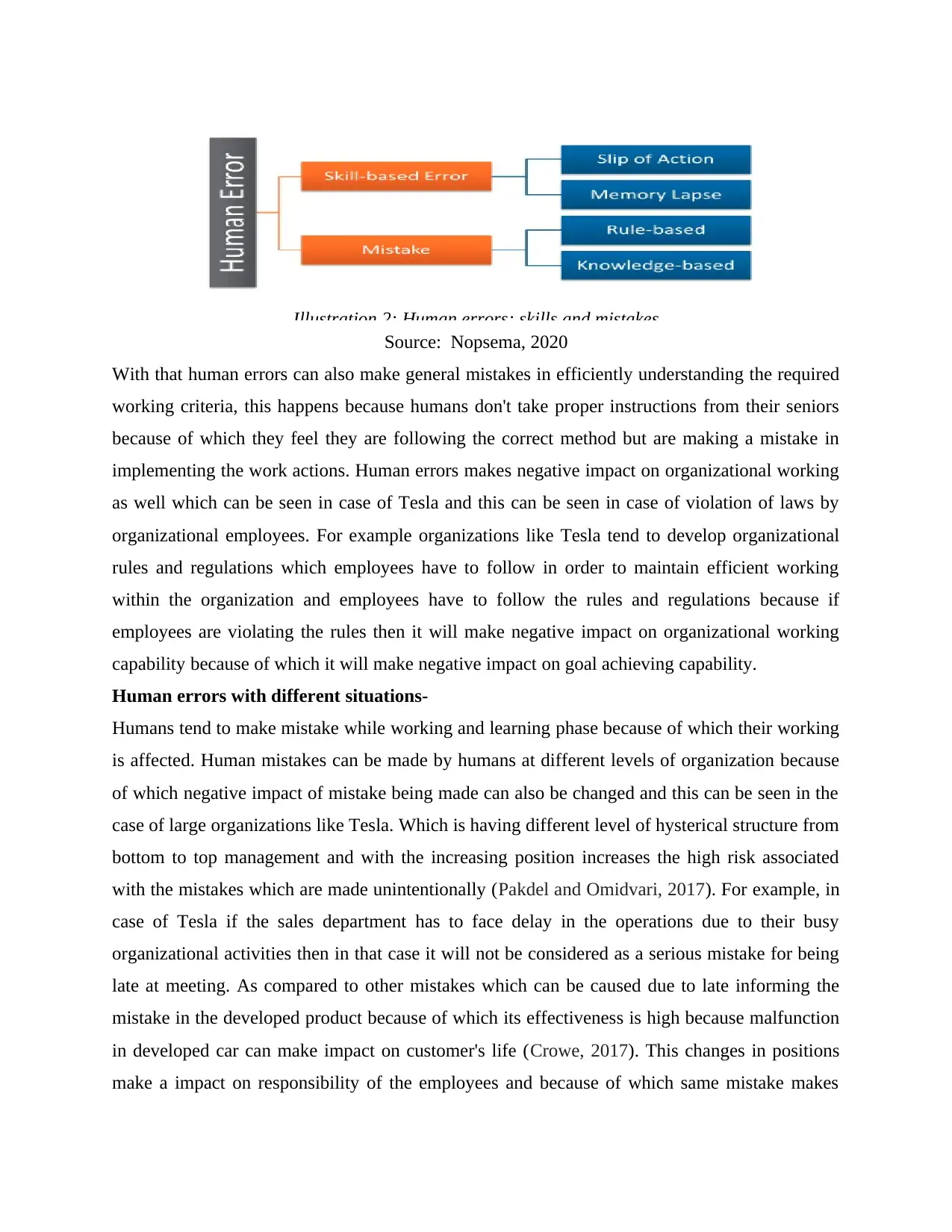
Source: Nopsema, 2020
With that human errors can also make general mistakes in efficiently understanding the required
working criteria, this happens because humans don't take proper instructions from their seniors
because of which they feel they are following the correct method but are making a mistake in
implementing the work actions. Human errors makes negative impact on organizational working
as well which can be seen in case of Tesla and this can be seen in case of violation of laws by
organizational employees. For example organizations like Tesla tend to develop organizational
rules and regulations which employees have to follow in order to maintain efficient working
within the organization and employees have to follow the rules and regulations because if
employees are violating the rules then it will make negative impact on organizational working
capability because of which it will make negative impact on goal achieving capability.
Human errors with different situations-
Humans tend to make mistake while working and learning phase because of which their working
is affected. Human mistakes can be made by humans at different levels of organization because
of which negative impact of mistake being made can also be changed and this can be seen in the
case of large organizations like Tesla. Which is having different level of hysterical structure from
bottom to top management and with the increasing position increases the high risk associated
with the mistakes which are made unintentionally (Pakdel and Omidvari, 2017). For example, in
case of Tesla if the sales department has to face delay in the operations due to their busy
organizational activities then in that case it will not be considered as a serious mistake for being
late at meeting. As compared to other mistakes which can be caused due to late informing the
mistake in the developed product because of which its effectiveness is high because malfunction
in developed car can make impact on customer's life (Crowe, 2017). This changes in positions
make a impact on responsibility of the employees and because of which same mistake makes
Illustration 2: Human errors: skills and mistakes
With that human errors can also make general mistakes in efficiently understanding the required
working criteria, this happens because humans don't take proper instructions from their seniors
because of which they feel they are following the correct method but are making a mistake in
implementing the work actions. Human errors makes negative impact on organizational working
as well which can be seen in case of Tesla and this can be seen in case of violation of laws by
organizational employees. For example organizations like Tesla tend to develop organizational
rules and regulations which employees have to follow in order to maintain efficient working
within the organization and employees have to follow the rules and regulations because if
employees are violating the rules then it will make negative impact on organizational working
capability because of which it will make negative impact on goal achieving capability.
Human errors with different situations-
Humans tend to make mistake while working and learning phase because of which their working
is affected. Human mistakes can be made by humans at different levels of organization because
of which negative impact of mistake being made can also be changed and this can be seen in the
case of large organizations like Tesla. Which is having different level of hysterical structure from
bottom to top management and with the increasing position increases the high risk associated
with the mistakes which are made unintentionally (Pakdel and Omidvari, 2017). For example, in
case of Tesla if the sales department has to face delay in the operations due to their busy
organizational activities then in that case it will not be considered as a serious mistake for being
late at meeting. As compared to other mistakes which can be caused due to late informing the
mistake in the developed product because of which its effectiveness is high because malfunction
in developed car can make impact on customer's life (Crowe, 2017). This changes in positions
make a impact on responsibility of the employees and because of which same mistake makes
Illustration 2: Human errors: skills and mistakes
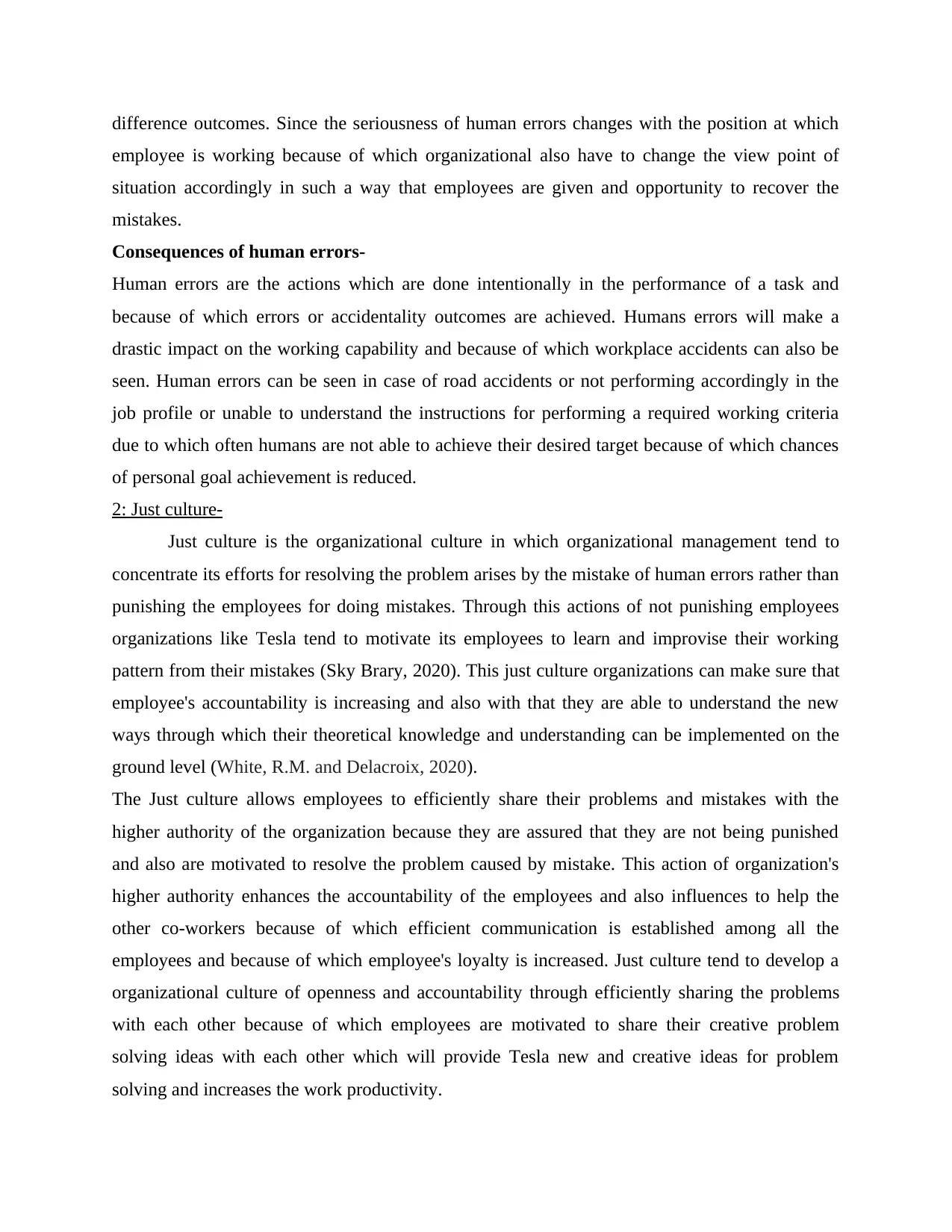
difference outcomes. Since the seriousness of human errors changes with the position at which
employee is working because of which organizational also have to change the view point of
situation accordingly in such a way that employees are given and opportunity to recover the
mistakes.
Consequences of human errors-
Human errors are the actions which are done intentionally in the performance of a task and
because of which errors or accidentality outcomes are achieved. Humans errors will make a
drastic impact on the working capability and because of which workplace accidents can also be
seen. Human errors can be seen in case of road accidents or not performing accordingly in the
job profile or unable to understand the instructions for performing a required working criteria
due to which often humans are not able to achieve their desired target because of which chances
of personal goal achievement is reduced.
2: Just culture-
Just culture is the organizational culture in which organizational management tend to
concentrate its efforts for resolving the problem arises by the mistake of human errors rather than
punishing the employees for doing mistakes. Through this actions of not punishing employees
organizations like Tesla tend to motivate its employees to learn and improvise their working
pattern from their mistakes (Sky Brary, 2020). This just culture organizations can make sure that
employee's accountability is increasing and also with that they are able to understand the new
ways through which their theoretical knowledge and understanding can be implemented on the
ground level (White, R.M. and Delacroix, 2020).
The Just culture allows employees to efficiently share their problems and mistakes with the
higher authority of the organization because they are assured that they are not being punished
and also are motivated to resolve the problem caused by mistake. This action of organization's
higher authority enhances the accountability of the employees and also influences to help the
other co-workers because of which efficient communication is established among all the
employees and because of which employee's loyalty is increased. Just culture tend to develop a
organizational culture of openness and accountability through efficiently sharing the problems
with each other because of which employees are motivated to share their creative problem
solving ideas with each other which will provide Tesla new and creative ideas for problem
solving and increases the work productivity.
employee is working because of which organizational also have to change the view point of
situation accordingly in such a way that employees are given and opportunity to recover the
mistakes.
Consequences of human errors-
Human errors are the actions which are done intentionally in the performance of a task and
because of which errors or accidentality outcomes are achieved. Humans errors will make a
drastic impact on the working capability and because of which workplace accidents can also be
seen. Human errors can be seen in case of road accidents or not performing accordingly in the
job profile or unable to understand the instructions for performing a required working criteria
due to which often humans are not able to achieve their desired target because of which chances
of personal goal achievement is reduced.
2: Just culture-
Just culture is the organizational culture in which organizational management tend to
concentrate its efforts for resolving the problem arises by the mistake of human errors rather than
punishing the employees for doing mistakes. Through this actions of not punishing employees
organizations like Tesla tend to motivate its employees to learn and improvise their working
pattern from their mistakes (Sky Brary, 2020). This just culture organizations can make sure that
employee's accountability is increasing and also with that they are able to understand the new
ways through which their theoretical knowledge and understanding can be implemented on the
ground level (White, R.M. and Delacroix, 2020).
The Just culture allows employees to efficiently share their problems and mistakes with the
higher authority of the organization because they are assured that they are not being punished
and also are motivated to resolve the problem caused by mistake. This action of organization's
higher authority enhances the accountability of the employees and also influences to help the
other co-workers because of which efficient communication is established among all the
employees and because of which employee's loyalty is increased. Just culture tend to develop a
organizational culture of openness and accountability through efficiently sharing the problems
with each other because of which employees are motivated to share their creative problem
solving ideas with each other which will provide Tesla new and creative ideas for problem
solving and increases the work productivity.
⊘ This is a preview!⊘
Do you want full access?
Subscribe today to unlock all pages.

Trusted by 1+ million students worldwide
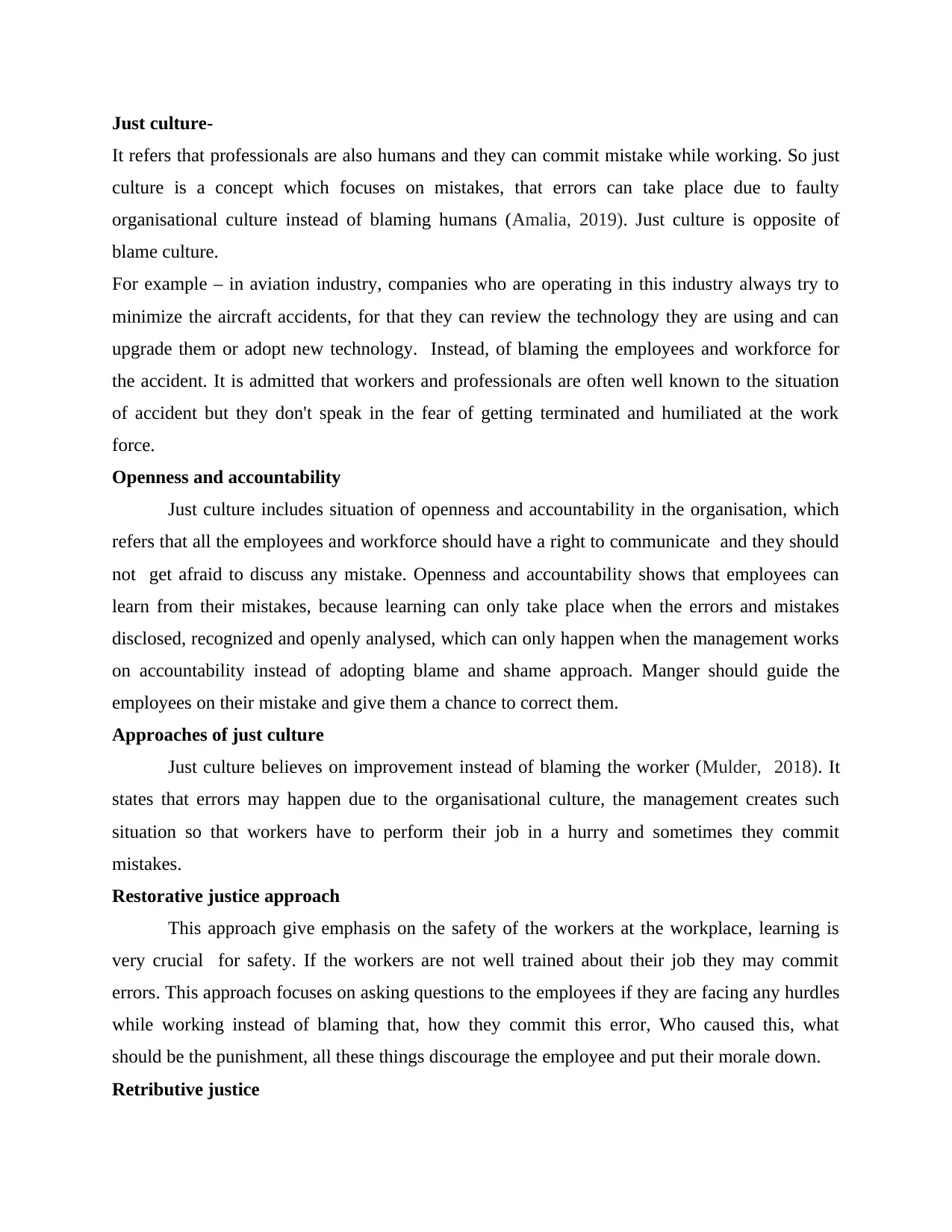
Just culture-
It refers that professionals are also humans and they can commit mistake while working. So just
culture is a concept which focuses on mistakes, that errors can take place due to faulty
organisational culture instead of blaming humans (Amalia, 2019). Just culture is opposite of
blame culture.
For example – in aviation industry, companies who are operating in this industry always try to
minimize the aircraft accidents, for that they can review the technology they are using and can
upgrade them or adopt new technology. Instead, of blaming the employees and workforce for
the accident. It is admitted that workers and professionals are often well known to the situation
of accident but they don't speak in the fear of getting terminated and humiliated at the work
force.
Openness and accountability
Just culture includes situation of openness and accountability in the organisation, which
refers that all the employees and workforce should have a right to communicate and they should
not get afraid to discuss any mistake. Openness and accountability shows that employees can
learn from their mistakes, because learning can only take place when the errors and mistakes
disclosed, recognized and openly analysed, which can only happen when the management works
on accountability instead of adopting blame and shame approach. Manger should guide the
employees on their mistake and give them a chance to correct them.
Approaches of just culture
Just culture believes on improvement instead of blaming the worker (Mulder, 2018). It
states that errors may happen due to the organisational culture, the management creates such
situation so that workers have to perform their job in a hurry and sometimes they commit
mistakes.
Restorative justice approach
This approach give emphasis on the safety of the workers at the workplace, learning is
very crucial for safety. If the workers are not well trained about their job they may commit
errors. This approach focuses on asking questions to the employees if they are facing any hurdles
while working instead of blaming that, how they commit this error, Who caused this, what
should be the punishment, all these things discourage the employee and put their morale down.
Retributive justice
It refers that professionals are also humans and they can commit mistake while working. So just
culture is a concept which focuses on mistakes, that errors can take place due to faulty
organisational culture instead of blaming humans (Amalia, 2019). Just culture is opposite of
blame culture.
For example – in aviation industry, companies who are operating in this industry always try to
minimize the aircraft accidents, for that they can review the technology they are using and can
upgrade them or adopt new technology. Instead, of blaming the employees and workforce for
the accident. It is admitted that workers and professionals are often well known to the situation
of accident but they don't speak in the fear of getting terminated and humiliated at the work
force.
Openness and accountability
Just culture includes situation of openness and accountability in the organisation, which
refers that all the employees and workforce should have a right to communicate and they should
not get afraid to discuss any mistake. Openness and accountability shows that employees can
learn from their mistakes, because learning can only take place when the errors and mistakes
disclosed, recognized and openly analysed, which can only happen when the management works
on accountability instead of adopting blame and shame approach. Manger should guide the
employees on their mistake and give them a chance to correct them.
Approaches of just culture
Just culture believes on improvement instead of blaming the worker (Mulder, 2018). It
states that errors may happen due to the organisational culture, the management creates such
situation so that workers have to perform their job in a hurry and sometimes they commit
mistakes.
Restorative justice approach
This approach give emphasis on the safety of the workers at the workplace, learning is
very crucial for safety. If the workers are not well trained about their job they may commit
errors. This approach focuses on asking questions to the employees if they are facing any hurdles
while working instead of blaming that, how they commit this error, Who caused this, what
should be the punishment, all these things discourage the employee and put their morale down.
Retributive justice
Paraphrase This Document
Need a fresh take? Get an instant paraphrase of this document with our AI Paraphraser
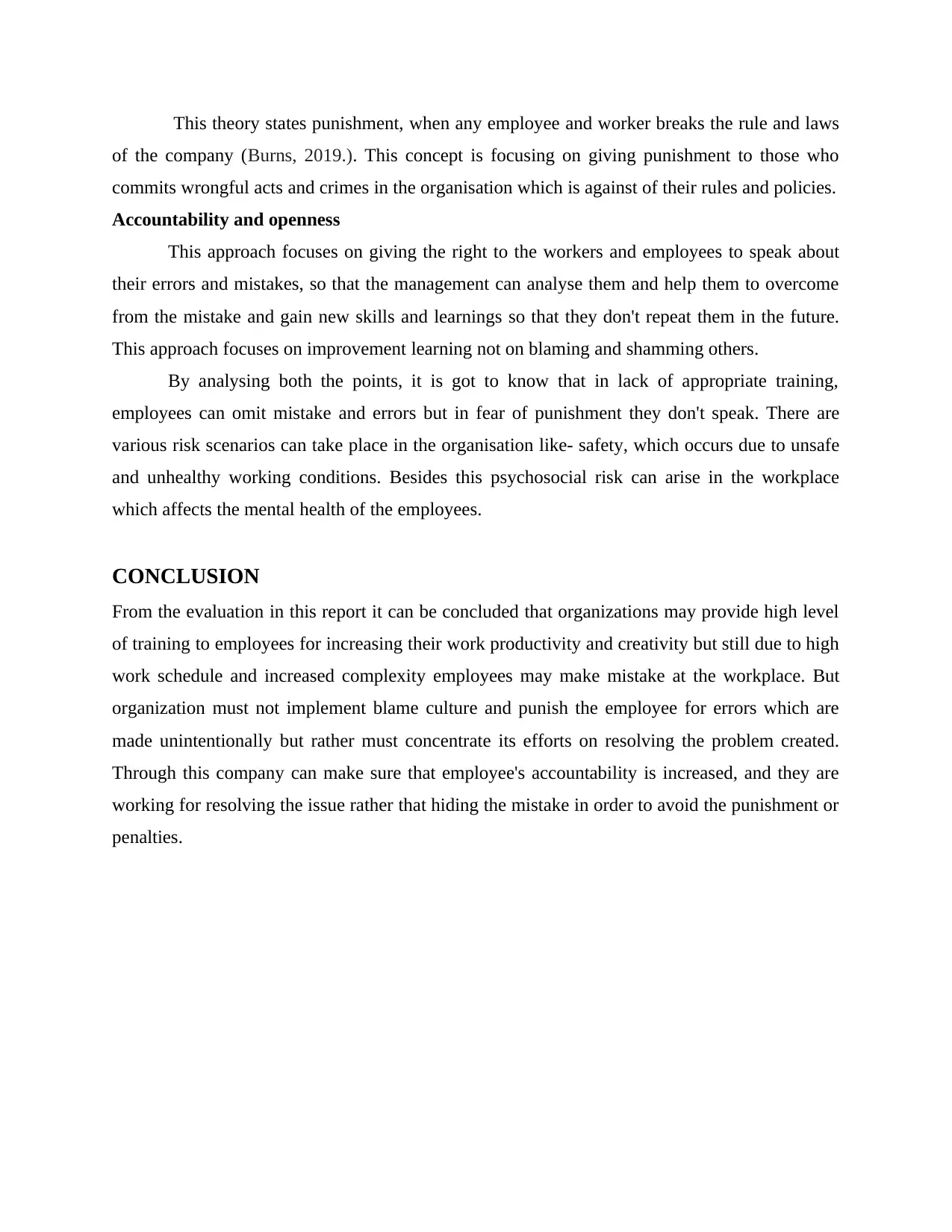
This theory states punishment, when any employee and worker breaks the rule and laws
of the company (Burns, 2019.). This concept is focusing on giving punishment to those who
commits wrongful acts and crimes in the organisation which is against of their rules and policies.
Accountability and openness
This approach focuses on giving the right to the workers and employees to speak about
their errors and mistakes, so that the management can analyse them and help them to overcome
from the mistake and gain new skills and learnings so that they don't repeat them in the future.
This approach focuses on improvement learning not on blaming and shamming others.
By analysing both the points, it is got to know that in lack of appropriate training,
employees can omit mistake and errors but in fear of punishment they don't speak. There are
various risk scenarios can take place in the organisation like- safety, which occurs due to unsafe
and unhealthy working conditions. Besides this psychosocial risk can arise in the workplace
which affects the mental health of the employees.
CONCLUSION
From the evaluation in this report it can be concluded that organizations may provide high level
of training to employees for increasing their work productivity and creativity but still due to high
work schedule and increased complexity employees may make mistake at the workplace. But
organization must not implement blame culture and punish the employee for errors which are
made unintentionally but rather must concentrate its efforts on resolving the problem created.
Through this company can make sure that employee's accountability is increased, and they are
working for resolving the issue rather that hiding the mistake in order to avoid the punishment or
penalties.
of the company (Burns, 2019.). This concept is focusing on giving punishment to those who
commits wrongful acts and crimes in the organisation which is against of their rules and policies.
Accountability and openness
This approach focuses on giving the right to the workers and employees to speak about
their errors and mistakes, so that the management can analyse them and help them to overcome
from the mistake and gain new skills and learnings so that they don't repeat them in the future.
This approach focuses on improvement learning not on blaming and shamming others.
By analysing both the points, it is got to know that in lack of appropriate training,
employees can omit mistake and errors but in fear of punishment they don't speak. There are
various risk scenarios can take place in the organisation like- safety, which occurs due to unsafe
and unhealthy working conditions. Besides this psychosocial risk can arise in the workplace
which affects the mental health of the employees.
CONCLUSION
From the evaluation in this report it can be concluded that organizations may provide high level
of training to employees for increasing their work productivity and creativity but still due to high
work schedule and increased complexity employees may make mistake at the workplace. But
organization must not implement blame culture and punish the employee for errors which are
made unintentionally but rather must concentrate its efforts on resolving the problem created.
Through this company can make sure that employee's accountability is increased, and they are
working for resolving the issue rather that hiding the mistake in order to avoid the punishment or
penalties.
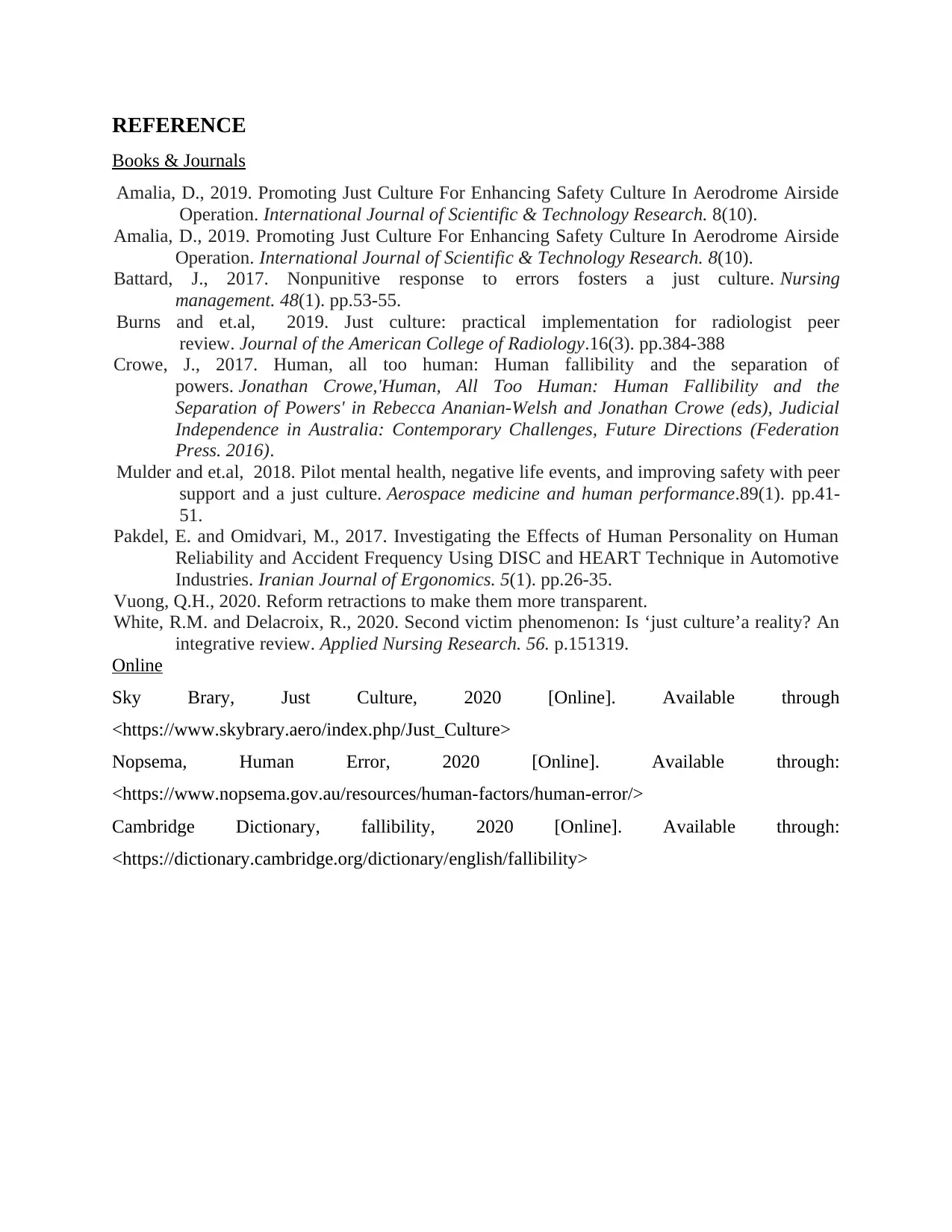
REFERENCE
Books & Journals
Amalia, D., 2019. Promoting Just Culture For Enhancing Safety Culture In Aerodrome Airside
Operation. International Journal of Scientific & Technology Research. 8(10).
Amalia, D., 2019. Promoting Just Culture For Enhancing Safety Culture In Aerodrome Airside
Operation. International Journal of Scientific & Technology Research. 8(10).
Battard, J., 2017. Nonpunitive response to errors fosters a just culture. Nursing
management. 48(1). pp.53-55.
Burns and et.al, 2019. Just culture: practical implementation for radiologist peer
review. Journal of the American College of Radiology.16(3). pp.384-388
Crowe, J., 2017. Human, all too human: Human fallibility and the separation of
powers. Jonathan Crowe,'Human, All Too Human: Human Fallibility and the
Separation of Powers' in Rebecca Ananian-Welsh and Jonathan Crowe (eds), Judicial
Independence in Australia: Contemporary Challenges, Future Directions (Federation
Press. 2016).
Mulder and et.al, 2018. Pilot mental health, negative life events, and improving safety with peer
support and a just culture. Aerospace medicine and human performance.89(1). pp.41-
51.
Pakdel, E. and Omidvari, M., 2017. Investigating the Effects of Human Personality on Human
Reliability and Accident Frequency Using DISC and HEART Technique in Automotive
Industries. Iranian Journal of Ergonomics. 5(1). pp.26-35.
Vuong, Q.H., 2020. Reform retractions to make them more transparent.
White, R.M. and Delacroix, R., 2020. Second victim phenomenon: Is ‘just culture’a reality? An
integrative review. Applied Nursing Research. 56. p.151319.
Online
Sky Brary, Just Culture, 2020 [Online]. Available through
<https://www.skybrary.aero/index.php/Just_Culture>
Nopsema, Human Error, 2020 [Online]. Available through:
<https://www.nopsema.gov.au/resources/human-factors/human-error/>
Cambridge Dictionary, fallibility, 2020 [Online]. Available through:
<https://dictionary.cambridge.org/dictionary/english/fallibility>
Books & Journals
Amalia, D., 2019. Promoting Just Culture For Enhancing Safety Culture In Aerodrome Airside
Operation. International Journal of Scientific & Technology Research. 8(10).
Amalia, D., 2019. Promoting Just Culture For Enhancing Safety Culture In Aerodrome Airside
Operation. International Journal of Scientific & Technology Research. 8(10).
Battard, J., 2017. Nonpunitive response to errors fosters a just culture. Nursing
management. 48(1). pp.53-55.
Burns and et.al, 2019. Just culture: practical implementation for radiologist peer
review. Journal of the American College of Radiology.16(3). pp.384-388
Crowe, J., 2017. Human, all too human: Human fallibility and the separation of
powers. Jonathan Crowe,'Human, All Too Human: Human Fallibility and the
Separation of Powers' in Rebecca Ananian-Welsh and Jonathan Crowe (eds), Judicial
Independence in Australia: Contemporary Challenges, Future Directions (Federation
Press. 2016).
Mulder and et.al, 2018. Pilot mental health, negative life events, and improving safety with peer
support and a just culture. Aerospace medicine and human performance.89(1). pp.41-
51.
Pakdel, E. and Omidvari, M., 2017. Investigating the Effects of Human Personality on Human
Reliability and Accident Frequency Using DISC and HEART Technique in Automotive
Industries. Iranian Journal of Ergonomics. 5(1). pp.26-35.
Vuong, Q.H., 2020. Reform retractions to make them more transparent.
White, R.M. and Delacroix, R., 2020. Second victim phenomenon: Is ‘just culture’a reality? An
integrative review. Applied Nursing Research. 56. p.151319.
Online
Sky Brary, Just Culture, 2020 [Online]. Available through
<https://www.skybrary.aero/index.php/Just_Culture>
Nopsema, Human Error, 2020 [Online]. Available through:
<https://www.nopsema.gov.au/resources/human-factors/human-error/>
Cambridge Dictionary, fallibility, 2020 [Online]. Available through:
<https://dictionary.cambridge.org/dictionary/english/fallibility>
⊘ This is a preview!⊘
Do you want full access?
Subscribe today to unlock all pages.

Trusted by 1+ million students worldwide
1 out of 9
Related Documents
Your All-in-One AI-Powered Toolkit for Academic Success.
+13062052269
info@desklib.com
Available 24*7 on WhatsApp / Email
![[object Object]](/_next/static/media/star-bottom.7253800d.svg)
Unlock your academic potential
Copyright © 2020–2025 A2Z Services. All Rights Reserved. Developed and managed by ZUCOL.





